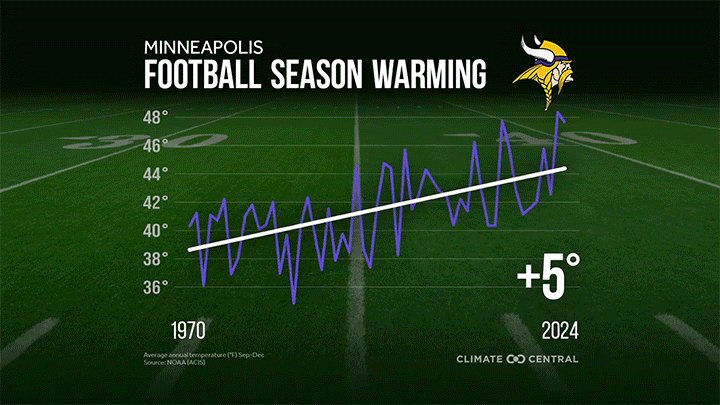Climate Matters•February 5, 2025
Football Season Warmup
KEY CONCEPTS
Ahead of the 2025 Super Bowl, Climate Central analyzed football season temperature trends in every National Football League (NFL) city from 1970 to 2024.
All 30 NFL cities have warmed during the regular season (September to December) — by 2.8°F on average.
The Raiders’ (Las Vegas) and Vikings’ (Minneapolis) home cities warmed the most (5.1°F and 5°F).
With the exception of Los Angeles, all other NFL cities have warmed at least 1°F.
In a matchup of the 2025 Super Bowl teams, the Philadelphia Eagles have experienced 3.1°F of warming compared to 2.2°F for the Kansas City Chiefs.
The 2025 Super Bowl will take place in New Orleans (home of the Saints), which has warmed 3.8°F since 1970.
These warming trends may take the chill out of some regular season games, but there’s no offseason for climate change.
NFL cities are also warming during summer and experiencing more risky heat extremes in the lead-up to the regular season.
The 30 NFL cities now experience an average of 14 more extremely hot days than in 1970, putting athletes at increasing risk of exertional heat illness during summer training camp and preseason games.
This Climate Matters analysis is based on open access data from the National Oceanic and Atmospheric Administration (NOAA). See Methodology for details.

METHODOLOGY
This analysis covers the 30 home cities for the 32 total NFL teams (two teams share stadiums: MetLife Stadium in the New York City area and SoFi Stadium in the Los Angeles area). Average temperature data during the regular football season (September 1 through December 31, 1970-2024) were obtained for each NFL city from the Applied Climate Information System, which is developed, maintained, and operated by NOAA’s Regional Climate Centers. Each city’s football season warming trend since 1970 is based on a linear regression of annual data over the period of analysis (1970 to 2024).


